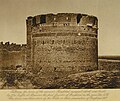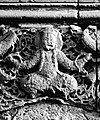Category:Bab Al-Talsim
Jump to navigation
Jump to search
Bab Al-Talsim. The Talisman Gate, built in 1220-1221 by al-Nasir, protected the eastern walls of Baghdad at the time of the siege.((in English) (1 March 2011) Baghdad: During the Abbasid Caliphate, Cosimo, Inc., pp. 291−292 ISBN: 978-1-61640-532-8. ). Destroyed in 1917 by the Ottomans
Fine 13th century carving and distinguishing ornamentation.
- Described by Ibn Jubayr in 1185 and mentioned in the accounts of the Mongol siege. "The inscription on the building reads that it was built and restored in 1221 by the Abbasid Caliph Nasser li-din-Illah as part of the construction of a large defensive wall intended to protect Baghdad from invaders and floods. It was named "Talisman" after the unusual inscriptions and figures carved on its upper walls and gate." "The decoration shows a pair of winged dragon-snakes and a human figure sitting cross-legged between them in a way to represent the glorious conqueror. They haven't been attributed to any sultan although they might be of a later addition carved to commemorate Sultan Murad IV entering Baghdad by 1638. These figures are carved in stone and lie on an intricate background of floral interweaving patterns incised in stone." archnet.org
- (22 April 2021) The Abbasid Caliphate: A History, Cambridge University Press, p. 237 DOI: 10.1017/9781316869567.005. "It has been suggested that an image al-Nasir had been carved over Bab al-Talsim, the Talisman Gate of Baghdad, in 618/1221, showing a seated figure holding two dragons at bay with his outstretched hands, was meant as symbolic of the caliph’s success in subordinating the Ismaʿili Grand Master and the Khwarazm shah. The image remained there up until World War I, when the gate was blown up by the retreating Ottoman troops in 1917."
Media in category "Bab Al-Talsim"
The following 14 files are in this category, out of 14 total.
-
1918 gate Baghdad Iraq by Sven Hedin.png 798 × 513; 715 KB
-
Talisman Gate (tower).jpg 1,290 × 1,083; 472 KB
-
Talisman Gate by Frederick Simpich, 1914.jpg 3,586 × 2,644; 4.3 MB
-
Talisman Gate in Baghdad.jpg 2,746 × 1,878; 2.51 MB
-
Talisman Gate ruler.jpg 667 × 800; 352 KB
-
Talisman Gate, destroyed by the Ottomans in 1917.jpg 1,722 × 2,290; 2.17 MB
-
Talisman Gate, Sarre, Friedrich Paul Theodor, 1911 (decoration).jpg 5,199 × 3,750; 12.69 MB
-
Talisman Gate, Sarre, Friedrich Paul Theodor, 1911 (gate).jpg 1,946 × 2,826; 3.88 MB
-
Talisman Gate, Sarre, Friedrich Paul Theodor, 1911 (inscription).jpg 2,708 × 326; 908 KB
-
Talisman Gate, Sarre, Friedrich Paul Theodor, 1911 (inscription, next).jpg 2,589 × 233; 622 KB
-
Talisman Gate, Sarre, Friedrich Paul Theodor, 1911 (ruler and drawing 2).jpg 2,230 × 1,100; 1.18 MB
-
Talisman Gate, Sarre, Friedrich Paul Theodor, 1911 (ruler and drawing).jpg 2,230 × 1,100; 1.48 MB
-
Talisman Gate, Sarre, Friedrich Paul Theodor, 1911 (ruler).jpg 1,162 × 1,355; 1.1 MB
-
Talisman Gate, Sarre, Friedrich Paul Theodor, 1911.jpg 2,814 × 3,533; 10.24 MB











